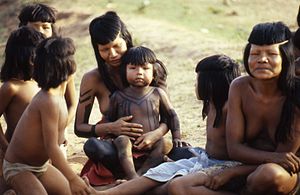Canela people
The Canela people, in what's now "Maranhão, Brazil," traditionally relied on a mix of gathering, hunting and gardening. Anthropologists William Crocker and Jean Crocker describe their society as "relatively egalitarian" with "minimal material resources and ceremonial hierarchy."[1]
They've been pushed off about 90 percent of their land since the early nineteenth century, they have shifted to a predominantly gardening-based mode of subsistence with gathering and hunting providing much less of their food. For the Canela, gardening is a means of resisting assimilation and maintaining autonomy. A Canela member named Renato has explained how gardening enables them to maintain a relative autonomy: "Today we are still preoccupied with creating gardens. Why? To not suffer from hunger. Because having rice, beans, fava beans, maize, peanut — then one can survive."[2]
Culture
The Canela live in circular-shaped villages where no household can be considered the head. Each household is managed by women. Lineage is matrilineal, and residence is matrilocal. Chris Knight comments on gender relations: "Men are certainly not more powerful than the women. The women own the homes [...] Home is where everything happens. It's the central power in the whole village."[3]
Before colonialism, the Crockers explain, "the Canela formerly had no god, did not worship or pray to any supernatural being. and did not try to influence supernarural entities to bring about improvements in their harvest and living condition."[4]
Historically, practices of public and private extramarital sex contributed to the culture's "strong ethic of caring and generosity."[5]
Decisions
Crocker and Crocker describe the historic Canela as being "governed by chiefs who gave orders that were obeyed because of custom rather than force."[6]
Dancing rituals in the middle of each village form the central focus of self-governance.[7]
Crime
At assemblies in the village center, residents share news and address disputes.[8]
Environment
Renzo Connors writes on the ecologically-oriented lifestyle of the Canela people:
The Canela’s subsistence gardening approach is totally different from monocrop agriculture. They work with nature using a conscious ecological and more biodiverse method.Typically in agriculture only a small variety of cash crops are grown in large fields covering acres upon acres of land where in the Amazon large sections of jungle are destroyed. For the Canela gardners instead of being dependent on a small variety of cash crops they cultivate over 300 varieties of plants to meet their subsistence needs. Instead of using destructive hellish machines like bulldozers, ploughs, and combine harvesters they use a slash and burn method to clear small patches just enough for them to use and their tools consist of a digging stick and woven baskets. They only use the same garden for two years and then not use the same area for at least eight years to allow the forest to regrow and return fertility to the soil.
The Canela’s vast knowledge of plants helps them determine which ones make good companions that will help each other grow, which ones are natural repellents to predatory insects that will attack the plants, and which plants to grow which will attract beneficial insects such as pollinizers. And likewise their vast knowledge of soil helps them to consciously plant to suit the 10 different soil groups in their area which will help prevent soil erosion, nutrients depletion, and combat against other harmful effects that are typical of agriculture. Their focus is for caring for the well-being of local biodiversity and the nonhuman inhabitants.
The Canel don’t see themselves as farmers but parents looking after their plant kin viewing their saved seeds and cuttings as their babies and their growing crops as their infants, genuinely loving them in the same way as if they were their human children caring for the plants as the plants care for them. They view the environment as consisting of human and nonhuman “selves”, and gardening as caretaking for themselves and their plant and human families.[9]
- ↑ William Crocker and Jean Crocker, The Canela: Kinship, Ritual, and Sex in an Amazonian Tribe (Nelson: Wadsworth/Thomson Learning, 2004), 97.
- ↑ Renzo Connors, " Title: Subsistence Gardening as Resistance," Oak: A Journal Against Civilization 3, retrieved from The Anarchist Library, https://theanarchistlibrary.org/library/renzo-connors-subsistence-gardening-as-resistance.
- ↑ Chris Knight, "Controversies over matriarchy," Radical Anthropology Group, 16 February 2021, https://vimeo.com/514318871, comments on Canela begin around 45:28.
- ↑ Crocker and Crocker, The Canela, 96.
- ↑ Crocker and Crocker, The Canela, 126.
- ↑ Crocker and Crocker, The Canela, 127.
- ↑ Knight, "Controversies."
- ↑ Crocker and Crocker, 119.
- ↑ Connors, " Subsistence Gardening as Resistance."
